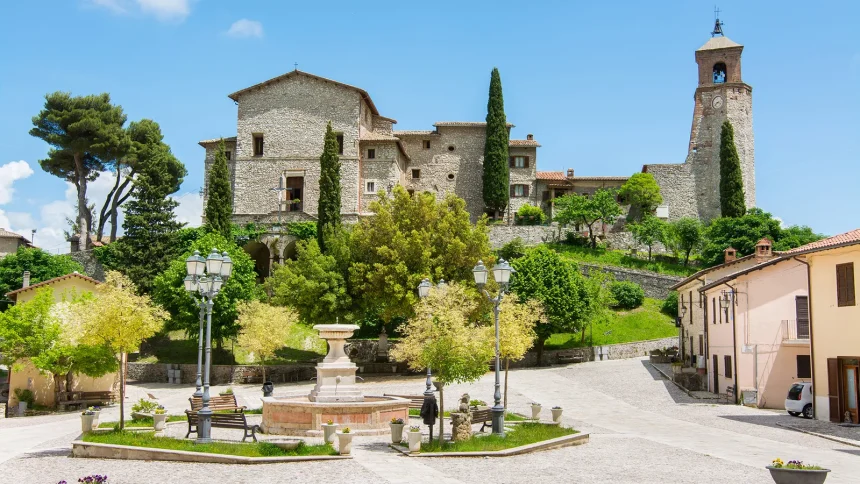Greccio, a medieval village in Italy, is one of the most beautiful but little-known villages in the country. Perched on the hillside of the Rieti province, approximately 80km north of Rome, a row of rustic stone houses crawls along the edge of the hill, peering down onto the expanse of the valley below.
For most of the year, Greccio’s 1,500 inhabitants live a peaceful agricultural life surrounded by a beech and oak forest where wild boar roam. However, for a few weeks during December, the village swells to welcome visitors from all over the world.
For Christians worldwide, Greccio is part of a pilgrimage route for St Francis of Assisi, a Catholic friar known for his love of nature, who was rumoured to be able to communicate with animals and believed in the virtue of voluntary poverty.
Most importantly for Greccio, this is where St Francis staged the world’s first nativity scene in a cave in the year 1223 in order to spread the Christmas story. Each year, more than 100,000 pilgrims and tourists flock here from Italy and abroad to marvel at the spectacular nativity scenes displayed all around town as part of the holiday celebrations, from miniature works nestled into the brickworks of walls to larger displays found in front of hotels and guesthouses.
While the nativity scene is celebrated here all year, this year marks the 800th anniversary of Saint Francis’ original nativity scene, and Greccio is preparing for an extra-special Christmas display and more pilgrims than ever before.
An ancient custom
Greccio was founded in the Middle Ages by Greeks fleeing war who settled here because of its defensible escarpment and natural tranquillity. They constructed a fortified town with defensive walls and a castle – remnants of which are still visible in parts of the surrounding forest.
It’s believed that St Francis came 90km south from Assisi to Greccio upon request of the Lord of Greccio, Giovanni Velita, in the 13th Century to preach to the villagers. Greccio’s woodland surroundings appealed to his love of nature, and he decided to settle here for the later part of his life.
St Francis built his Sanctuary as a residence as well as a place of meditation and worship 1.5 kilometers from Greccio’s center. It is a magnificent sight, partly carved into the rockface of the mountains halfway up a cliff.
In the years 1219-1220, St Francis visited Bethlehem in historical Palestine – the Holy Land – as part of his own pilgrimage of faith. On his return to Greccio, wanting to bring people closer to their faith through the memory of Christ’s birth, he decided to recreate the atmosphere of Jesus’ birth scene in the year’s Christmas celebrations.
On December 24, 1223, he organized a midnight mass that included a re-enactment of the event, with villagers playing Mary and Joseph and a rag doll as baby Jesus. St Francis even brought an ox and a donkey to complete the image of Jesus being born in a barn. The aim was to educate and inspire the villagers of Greccio about the celebration of Christmas – not just as a historical event, but as something real they could imagine and believe in.
This first nativity scene was a success among the villagers of Greccio, and St Francis started a yearly tradition that was then spread around the world by missionaries and pilgrims who had witnessed this celebratory event. The recognition of Greccio as the origin of the nativity scene has led to the town being dubbed the “Franciscan Bethlehem” by worshippers.
Today, visitors to the Sanctuary can enter the Cappella del Presepio, the Chapel of Nativity Scene, to see a partially restored ancient mural of a nativity scene by an unknown painter that marks the place where St Francis held the mass.
They can also see images of St. Francis painted on the walls around the village and visit the International Nativity Museum in the Church of Santa Maria, which displays nativity scenes made by different Christian orders in Italy and around the world.
Locals treasure it. Annabella Colandrea, who lives in nearby Rieti, frequently visits the Sanctuary to rest and relax on the terrace overlooking the Rieti Valley. She is particularly moved by the origin story of the nativity scene, having visited Greccio and its museum as a child, and continues to do so as an adult.
“When I was a kid, I used to look at the lights, the figurines, and the houses with wide eyes,” she said. “Now, every time I return, the emotion is the same; I feel like a child again.”






